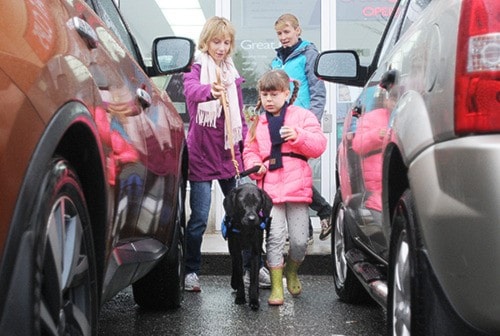Kaya Nelson was diagnosed with autism just before she turned three years old.
It was a devastating diagnosis for her parents, who suspected something was different about their little girl.
Physically, Kaya was not on the growth charts where other children of her age were and she was not speaking.
“She had no language, yet. She was three, so there was no language. We kind of had a hard time communicating There was a lot of frustration and anxiety,” explained her mother, Iveta.
Her parents were worried about Kaya’s future schooling, and her safety.
In addition to autism, Kaya has hypotonia, low muscle strength, and coloboma – an eye that didn’t develop properly – so she is partially visually impaired.
“For us, it’s safety because Kaya is sensory sensitive. Everything that is a hard noise or a different noise, like the cars on the road, she would just go and bolt,” said Iveta.
 But now Kaya, 8, has a new friend.
But now Kaya, 8, has a new friend.
Her name is Dianne, a black labrador who will graduate from Autism Support Dogs, a division of B.C. and Alberta Guide Dogs, on Friday, along with Kaya.
The pair have been training together, working one-on-one with Autism Support Dog instructors Laura Hilbert and Nicola Landells for the past two weeks.
The first week was spent training Iveta on how to handle the dog, then this past week Dianne was introduced to Kaya.
Iveta could see a difference in her daughter right away.
“She calls her friend, she doesn’t call her dog,” said Iveta.
“When she’s walking along and she hears the sound of the car, it could be anywhere, approaching on a quiet street or in the car park, she would just stop and stand still,” continued Iveta.
“Now she has continued to walk even though she is still aware of it.”
Dianne is tethered to Kaya’s waist with a handle for her to hold on to so it feels like she is walking along with the dog.
Kaya can’t bolt now because she is attached to Dianne.
Labradors and golden retrievers are good natured dogs who like to work, are good with families, easy to train and intelligent.
That’s what makes them the optimal dogs for this type of work, Landells said.
Typically, it is a two- to three-year wait for a support dog.
Puppies start their training at the B.C. and Alberta Guide Dogs at seven to eight weeks, when they go to a puppy raiser, who takes them everywhere with them.
“They go on the SkyTrain, they go on buses, they go in grocery stores, they go in shopping malls, they go to theatre, so they are used to every type of environment. They go walking on busy streets, they go walking on trails in the country,” said Landells.
At 14 months, the puppies start advanced training, in which they work with instructors for five months.
Then they are matched with a family.
Environments such as busy households are taken into consideration.
“There are many different criteria that we consider. It’s not just your next on the list, you get the next dog that’s available. If that dog is not going to fit into the city environment because it doesn’t like traffic, it’s not going to work,” said Landells.
Iveta is hoping that now they will be able to do more things as a family.
For the past six years, they haven’t been able to a restaurant, to the theatre or even to Kaya’s 11-year-old sister’s recitals.
Now Kaya is calmer, which means that she has less anxiety and doesn’t start acting up.
“I have less anxiety and the whole household is calmer,” said Iveta.
On Friday, Dianne has to pass an Assistance Dogs International test to ensure the dog and handler are safe and controlled in public. This will give them the right to go into any public space, the same as a guide dog.
Landalls and Hilbert be with the family until Friday, then follow up with them in three months. Then, every year Dianne and her new family will have to pass the ADI test.
Kaya has already become attached to Dianne, and not just physically. While walking through a mall this past week, Kaya needed a break and she laid down on Dianne. She was also able to overcome her fear of public restrooms, a place she normally wouldn’t go because of the loud sounds of flushing and hand dryers.
Iveta is happy that Kaya is talking more, expressing her feelings, and being more open with what is going on in her life.
She also likes Kaya’s new sense of responsibility.
“We tell her, ‘Kaya, you need to make sure that Diane is safe.’ But it’s actually that Diane is helping Kaya to be safe.”
